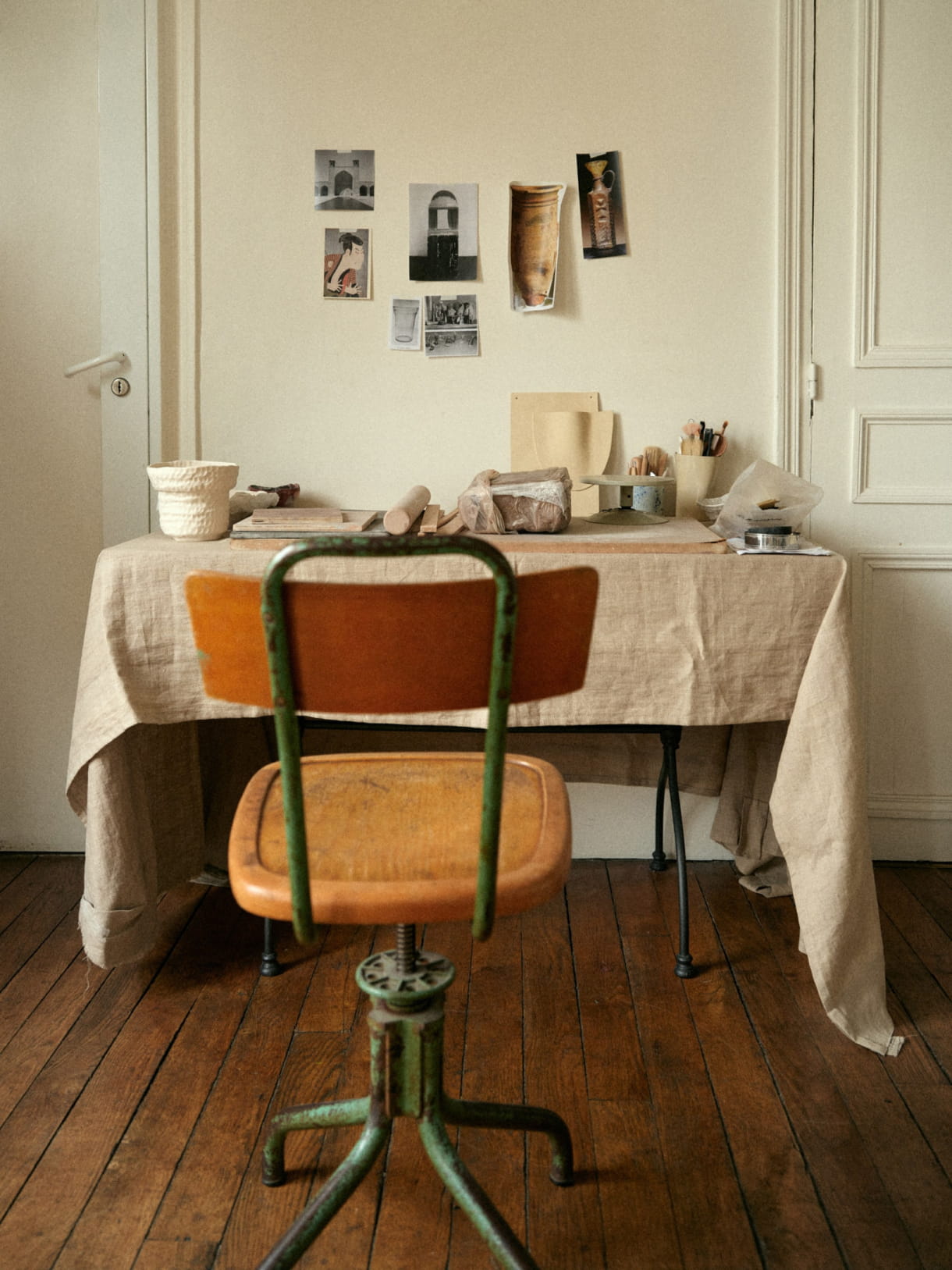CRÉDIT PHOTOS : Florian Touzet
When Lorraine is asked what drew her to ceramics, she recalls an initiatory trip to Uzbekistan, the Iranian terracotta pottery brought back by her grandmother, and her fascination with craftsmanship. Inspired by antiquity, nature and contemporary art, she explores form and material through her creations under the evocative name of Apollonie Ceramics. Meet a passionate artist with a gift to create a universe rich in poetry and sensitivity.
Why did you choose the name “Apollonie Ceramics” for this creative project?
I found it at an exhibition on la nouvelle Athène a few years ago, and it immediately appealed to me. It reminds me of my neighborhood in Paris, and of Greece, a place I particularly love for its history and mythology, but also for its arid stone landscapes, whitewashed walls and intense blue hues; above all, it symbolizes sunshine, beauty, art, poetry...
I liked the fact that its name is somewhat intriguing, curious and mysterious, and that for me it's the starting point of a universe.

When and how did you discover ceramics?
It all started with travels. A long time ago, my grandmother brought back some terracotta pottery from Iran, which left a lasting impression on me as a child.
When I was a student, as soon as I could I would travel far and wide, always on the lookout for handicrafts. In 2010, I visited a ceramics workshop in Uzbekistan for the first time, and the idea sparked in me and stayed.
So in 2013, when I moved to Montreal, I immediately began training, and the thought of making my own objects quickly became an obsession.
At that time, I discovered Arts and Crafts and a new generation of Anglo-Saxon ceramists who were bringing something new and creative to this material, in a rather intuitive and spontaneous practice; it was inspiring.
There's something magical about ceramics: working with the material, the alchemy, the range of possibilities, but also the return to simplicity and slowness, to humility.
What are your sources of inspiration?
There are many, of course. I'm fascinated by antiquity and archaeology, nature, folk art and ancient traditions, and sometimes architecture or contemporary art. What often touches me is the understated quality of a work, how it manages to express something strong and poetic, in a very simple way.


How would you describe the creative process behind your ceramics?
Sometimes it starts with an idea, a subject that interests me, sometimes with a shape. I keep a little notebook with me all the time, in which I write whenever I think of something, and then I test what I like best. I like projects that push back the boundaries between art and function, or repurpose a precious object into something very raw, and vice versa. There's a dimension of fun and play in this process that's very important to me.
What technique do you use most often?
I work mainly in modeling, often combining different techniques on the same piece, like pinching, slab building and coiling.

How did you come to train for this?
I started out in Montreal about ten years ago, that's where I got my training. I joined a community workshop called l'Aluminé, and I loved it. I learned a lot from other ceramists, there was room for experimentation, it was a real haven of freedom. When I returned to Paris in 2020, I had to start all over again, the materials and methods weren't the same. This empowered me to further develop my practice.
Which piece would you say is most representative of your work?
If I had to choose, I'd say my boxes: they have a very raw, ornamental edge that I like. And I also like the idea of the box as an object: you can put things you value in it, memories, words, intimate or precious things...


In 2023, you developed a jewelry collection with the Fabrique Nomade workshop. Can you tell us more about it?
I've always loved the idea of working with other materials; of finding a playground within different craft practices in which to transpose my universe. It inspired me to take a jewelry-making course in Montreal, during which I imagined pieces based on the shapes I was working on in ceramics at the time. I'd kept a few of my attempts, and last year I finally found the time to pick them up again and turn them into a collection of rings and earrings. I worked on a very small limited series in silver and gold with the production workshop of Fabrique Nomade, a Paris-based association that promotes the professional integration of refugee and migrant artisans in France. This approach meant a lot to me.
What is your latest artistic inspiration?
The Studio Mumbai exhibition at the Fondation Cartier: it’s a mix of art and architecture, natural materials and traditional skills, expressed in a very modern way. It's beautiful.


Any upcoming projects you’d like to share with us?
This summer I'll be in residency at the Château de la Haute-Borde, working on a more sculptural project that focuses on folk traditions, beekeeping practices and the living. I look forward to sharing it with you.
What does Sessùn mean to you?
A sunny, sensitive universe of beautiful materials. The style is never ostentatious, always subtle. The bonds that Sessùn forges with the creative world, and its commitment to promoting handmade products and craftsmanship, is something that also touches me deeply.
Check out Lorraine Grouvel's look






